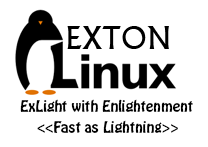 NEWS 200703 ABOUT ExLight
NEWS 200703 ABOUT ExLight
I’ve made a new version of ExLight with the Enlightenment 0.23.1 Desktop environment, Refracta Snapshot (create your own Debian Bullseye System), Nvidia Graphics Driver 440.100 and Calamares 3.2.26-1 Installer Framework. The very nice Enlightenment theme NightBlue is used. It will be used also after a hard drive installation.
New sources 200703
This new version of ExLight is based on Debian testing 11 Bullseye. Build 200703 is a total rebuild of ExLight. The ISO file size is of only 1270 MB, which means that ExLight now can run even faster from RAM. I.e. load to RAM – screenshot.
KERNEL
ExLight Build 200703 uses kernel 5.7.6-exton, corresponding Kernel.org‘s kernel 5.7.6.
Installed packages
Study all installed packages in ExLight Build 200703.
LOGIN and passwords
After booting up ExLight (built with Refracta) from DVD/USB stick you’ll end up in Enlightenment as the ordinary user user. The password for user is live. The password for root is root. After the installation of ExLight to hard disk you’ll get the chance to create your own ordinary user. When logged in as user you can use Sudo to become root. (Command: sudo su). NOTE: After a hard drive installation of ExLight you can still log in to Enlightenment as root, but you’ll have to create a new password for root. That’s done by running the command sudo passwd root (as the ordinary user user).
VirtualBox and VMware
ExLight Build 200703 runs very well in VirtualBox and VMware. Maybe you’ll have to use boot alternative 4 (failsafe). You can use Calamares Installer also in VirtualBox and VMware without any problems. NOTE: I’ve installed the Guest Additions in VirtualBox so you can run ExLight in full scale.
WIRELESS connections
In Build 200703 NetworkManager, WPA supplicant and ConnMan are installed. Use the one you prefer. NOTE1: You may have to replace /etc/resolv.conf with /etc/resolv.conf-WORKING before you can connect – screenshot. Sort of a “bug”. After a hard drive install you can make the file /etc/resolv.conf unchangeable with the command: sudo chattr +i /etc/resolv.conf
NOTE2: Study /etc/resolv.conf-WORKING and change it (if necessary) to suit your needs – screenshot. Keep a copy of resolv.conf-WORKING before you change the filename. Watch a screenshot about how to use NetworkManager. And about how to use ConnMan.
Using the Nvidia proprietary driver
If you want (and can) use Nvidia’s proprietary Graphics Driver 440.100 you shall boot up ExLight using boot alternative 3 (fail-safe). Then open up a terminal and run sudo nvidia-xconfig. Log out. NOTE: Maybe you don’t even have to run the command nvidia-xconfig. I.e. your Nvidia card will be used automatically. Check that by starting Nvidia X Server Settings under the Menu >> Preferences. If you can’t reach X/Enlightenment after running nvidia-xconfig etc. your card isn’t supported. Delete xorg.conf with sudo rm /etc/X11/xorg.conf and run the command startx. Or reboot your computer. NOTE: To be able to install the Nvidia driver running kernel 5.7.6 it had to be patched.
MOVIE about Calamares Installer
Watch a movie about the Calamares installation process in VirtualBox. You can use the Calamares 3.2.26-1 Installer Framework to install ExLight to your computer in any language. You can even use Calamares in VirtualBox and VMware – i.e. non-efi computers. Watch this animated GIF. (It’s for DebEX Budgie, but works in the same way in ExLight).
Or watch this slideshow.
Spotify
You can easily install Spotify in ExLight (even while running the system live). Just run the command sudo apt update followed by sudo apt install spotify-client.
Important about Refracta
You can use the Refracta Snapshot (pre-installed in ExLight) to create your own installable Debian Live System once you have installed ExLight to hard drive. I mean change everything and then create a whole new Debian live system. When you start Refracta Snapshot it will look like this. You don’t even have to install ExLight to hard drive before you can use the Refracta Snapshot. If you have plenty of RAM you can create a new (your own!) Debian system while running ExLight from DVD or a USB stick. Please note that the whole Refracta process (creating your new ISO) only will take 10 – 50 min! You’ll find the ISO in /home/snapshot. NOTE: You may have to run Refracta Snapshot in three steps (1 – 3) before your new ISO is ready.
THE REAL McCoy
ExLight is a pure Debian system. I.e. no traces of Ubuntu, Kubuntu etc. New releases of Ubuntu are always based on Debian. So is ExLight.
SCREENSHOTS
1. The Enlightenment 0.23.1 Desktop for root
2. The Enlightenment 0.23.1 Desktop for the ordinary user user running Calamares
3. Connection from ExLight to a Windows computer using Samba
4. Using ConnMan for WiFi connections
5. Using NetworkManager for WiFi connections
6. ExLight Nvidia Settings
7. ExLight running Refracta Snapshot in three steps
 DOWNLOAD
DOWNLOAD
This ExLight build has been replaced by Build 210125…
andex.exton.net – latest is AndEX 10 (with GAPPS) and AndEX Pie 9.0 (also with GAPPS)!
and
about my Android 11, 10, Pie, Oreo, Nougat, Marshmallow and Lollipop versions for Raspberry Pi 4 and 3/2 at
raspex.exton.se – latest is RaspAnd 11 (without GAPPS) and RaspAnd Oreo 8.1 (with GAPPS)!
